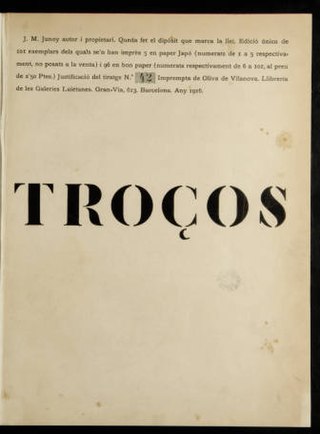
Lluís Companys i Jover was a Catalan politician who served as president of Catalonia from 1934 and during the Spanish Civil War.

Alejandro Lerroux García was a Spanish politician who was the leader of the Radical Republican Party. He served as Prime Minister three times from 1933 to 1935 and held several cabinet posts as well. A highly charismatic politician, he was distinguished by his demagogical and populist political style.

The German language satirical magazine Ulk was printed from 1872 until 1933 by the publisher Rudolf Mosse. Its headquarters was in Berlin, Germany.
José Escobar Saliente was a Spanish comic book writer and artist, born in Barcelona. He signed as Escobar, and is most famous for his creation Zipi y Zape, as well as the character Carpanta. He was also an author and a theater actor, as well as one of the pioneers of animation in Spain during the 1920s, and worked on early Spanish animated movies, such as La ratita que barría la escalerita.
La Campana de Gràcia was a seminal Catalan weekly magazine of satire, written bilingually in Catalan and Spanish of the late 19th and early 20th century, staunchly supportive of republicanism and anticlericalism. The headquarters was in Barcelona.

Lluís Bagaria i Bou one of the most important Spanish caricaturists in the first half of the 20th century. His drawings, in a synthetic and decorative style, were published in the most important journals of Spain, including L'Esquella de la Torratxa and ¡Cu-Cut! between 1906 and 1940.

The 1888 Barcelona Universal Exposition was Spain's first International World's Fair and ran from 8 April to 9 December 1888. The second one in Barcelona was held in 1929).

¡Cu-cut! was a Catalan illustrated satirical magazine, written in Catalan. Published in Barcelona between 1902 and 1912, it followed the political line marked by Francesc Cambó's Lliga Regionalista.

L'Esquella de la Torratxa was an illustrated satirical weekly magazine, written in Catalan. Published in Barcelona between 1872 and 1939, it was well known for its pro-republican and anti-clerical stance and would become one of the most important Catalan publications of all times.
Enric Roig Masriera was a violinist, poet and musicologist.

Troços is an avant-garde Catalan magazine published for the first time in 1916. It was directed by Josep Maria Junoy, who was also the owner of the magazine. Only 101 copies were printed of the first edition. This number had 8 pages and the measurements were 223 x 135 mm. Its impression was a high quality one and it was done in the printing house Oliva de Vilanova. Its price was 2.50 pesetas.

Buen Humor was a satirical and literary magazine published in Madrid, Spain, between 1921 and 1931. It was among the most read satirical magazines in the country during its lifetime in addition to Gutiérrez.

Josep Lluís Pellicer i Fenyé was a Spanish painter, illustrator and cartoonist.

Miquel Badia i Capell (1906–1936) was a prominent figure of radical Catalan separatism during the days of the Second Spanish Republic, member of Estat Català and the JEREC, Chief of Public Order of the Generalitat of Catalonia. He became known among his followers as Capità Collons.

Jaime Carner Romeu was a Spanish lawyer, businessman and politician from Catalonia. He was a deputy in the Cortes before World War I, then pursued a career as a corporate lawyer until the Second Spanish Republic when he was again elected deputy. He was Minister of Finance from 1931 to 1933.
Events from 1931 in Catalonia.

La Veu de Catalunya was a Catalan newspaper founded by Enric Prat de la Riba that was published in Barcelona from 1 January 1899 to 8 January 1937, with two editions daily.
Francesc Isgleas i Piarnau was a Catalan anarcho-syndicalist.

Josep Dencàs i Puigdollers was a Catalan nationalist politician active in the Republican Left of Catalonia.














